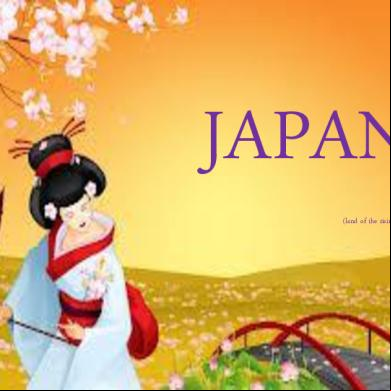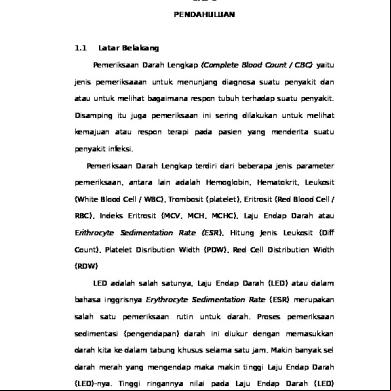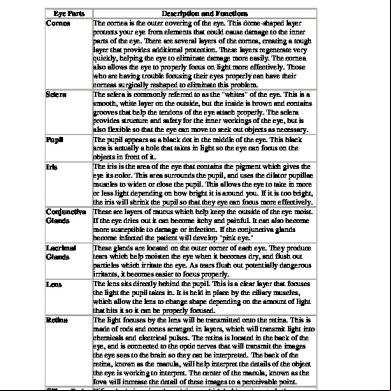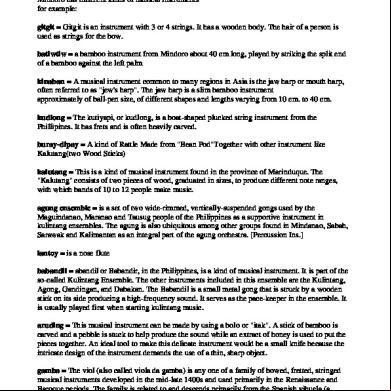Japan Instrument 372k3y
This document was ed by and they confirmed that they have the permission to share it. If you are author or own the copyright of this book, please report to us by using this report form. Report 2z6p3t
Overview 5o1f4z
& View Japan Instrument as PDF for free.
More details 6z3438
- Words: 957
- Pages: 2
Japan Instrument Odaiko- (big drum). The physical energy and sheer excitement of an Odaiko performance is an integral part of many Japanese matsuri (festivals). Tsuzumi (hourglass-shape) – There are two varieties, the smaller kotsuzumi and the larger otsuzumi. They are used in both noh and kabuki performances. The kotsuzumi is held on the right shoulder and the player alters the tone by squeezing the laces. The otsuzumi is placed on the left thigh Tsuridaiko – a large hanging barrel drum Taiko - is a Japanese drum that comes in various sizes and is used to play a variety of musical genres. It has become particularly popular in recent years as the central instrument of percussion ensembles whose repertory is based on a variety of folk and festival music of the past. Koto - is a 13-string zither, about two meters long and made of Paulownia wood. It is plucked using picks on the thumb and first two fingers of the right hand, while the left hand can be used to modify pitch and tone. Koto is used in an ensemble in gagaku or as a solo instrument. Shamisen- is a plucked stringed instrument. Its construction follows a model similar to that of a guitar or a banjo, employing a neck, and strings stretched across a resonating body. The neck of the shamisen is fretless, and is slimmer than that of a guitar or a banjo.
Shakuhachi- the most famous flute made from bamboo. It has 4 or 5 finger holes on the front face and a thumbhole on the rear face. As with other instruments above, it was imported from China for gagaku. Nokan - a parallel, bamboo flute (fue) is the only melodic instrument used in noh. The melody of the flute has no specific pitch relationship with the melody of the chanting. Hichiriki - is a double reed Japanese fue (flute) used as one of two main melodic instruments in Japanese gagaku music, the other being the ryūteki. Sho - is a Japanese free reed musical instrument that was introduced from China during the Nara period. Shinobue – also called takebue in the context of Japanese traditional arts) is a Japanese transverse flute or fue that has a high-pitched sound. Ryūteki - literally "dragon flute" is a Japanese transverse fue made of bamboo. It is used in gagaku.
China Instrument Yueqin - Moon-shaped lute with shorter neck and four strings, played with a spectrum, used for accompanying local operas.
Pipa - Four-stringed lute with 30 frets and a pear-shaped body. This instrument has an extremely wide dynamic range Biwa - is a Japanese short-necked fretted lute, and remarkable expressive power. often used in narrative storytelling. The biwa is the chosen instrument of Benten, the goddess of Erhu - Two-stringed fiddle and one of the music, eloquence, poetry, and education in most popular Chinese instruments. It is used as Japanese Shinto. a solo instrument as well as in small ensembles or large orchestra, and by various ethnic groups.
Yunluo - Literally "cloud gongs" or "cloud of gongs", the yunluo is a set of ten small tuned gongs mounted in a wooden frame. The yunluo's gongs are generally of equal diameter but different thickness. The thicker gongs produce a higher pitch. Sheng - Sheng, or Chinese mouth organ, looks like a set of panpipes, with 12 to 36 bamboo pipes. Each pipe is of different length with a brass reed at the bottom and a hole that must be blocked in order for the note to sound. This makes it possible to sound several notes simultaneously, so chords and melody can be performed at the same time. Sheng is one of the oldest Chinese musical instruments. Dizi - Dizi is the traditional Chinese flute. It can have a membrane over an extra hole to give the characteristic rattle effect. The player plays the Dizi by blowing across the mouthpiece and produces the different notes by stopping the six holes found in the rod
constructed with 21 or more numbers of strings. It is probably the best-known traditional Korean musical instrument. Geomungo - Six-string plucked zither is a traditional Korean stringed musical instrument of the zither family of instruments with both bridges and frets. Scholars believe that the name refers to Goguryeo and translates to "Goguryeo zither" or that it refers to the color that translates to "black crane zither". Haegum (two-string vertical fiddle) – It has a rod-like neck, a hollow wooden soundbox, two silk strings, and is held vertically on the knee of the performer and played with a bow. Piri - used in both the folk and classical (court) music of Korea. It is made of bamboo. Its large reed and cylindrical bore gives it a sound mellower than that of many other types of oboe.
Changgo - is the most widely used drum used in the traditional music of Korea. It is available in Zheng - An ancient Chinese instrument that has most kinds, and consists of an hourglass-shaped an arched body with two heads made from animal skin. The surface and an elongated-trapezoid with 13 to two heads produce sounds of different pitch and 21 strings stretched timbre, which when played together are believed over individual bridges. Its playing range spans to represent the harmony of man and woman. three to four octaves. Pengling - These are two small bells made of high-tin bronze, without internal clappers, and hemispheric or bottomless gourd-like in shape. The instrument has a delicate, clarion and melodious tone. It is a coloring rhythmic instrument, either in ensembles or in theater music, bringing an effect of peaceful dreams.
Korea Instrument Kayagum (gayageum) - is a traditional Korean zither-like string instrument, with 12 strings, although more recently variants have been
Shakuhachi- the most famous flute made from bamboo. It has 4 or 5 finger holes on the front face and a thumbhole on the rear face. As with other instruments above, it was imported from China for gagaku. Nokan - a parallel, bamboo flute (fue) is the only melodic instrument used in noh. The melody of the flute has no specific pitch relationship with the melody of the chanting. Hichiriki - is a double reed Japanese fue (flute) used as one of two main melodic instruments in Japanese gagaku music, the other being the ryūteki. Sho - is a Japanese free reed musical instrument that was introduced from China during the Nara period. Shinobue – also called takebue in the context of Japanese traditional arts) is a Japanese transverse flute or fue that has a high-pitched sound. Ryūteki - literally "dragon flute" is a Japanese transverse fue made of bamboo. It is used in gagaku.
China Instrument Yueqin - Moon-shaped lute with shorter neck and four strings, played with a spectrum, used for accompanying local operas.
Pipa - Four-stringed lute with 30 frets and a pear-shaped body. This instrument has an extremely wide dynamic range Biwa - is a Japanese short-necked fretted lute, and remarkable expressive power. often used in narrative storytelling. The biwa is the chosen instrument of Benten, the goddess of Erhu - Two-stringed fiddle and one of the music, eloquence, poetry, and education in most popular Chinese instruments. It is used as Japanese Shinto. a solo instrument as well as in small ensembles or large orchestra, and by various ethnic groups.
Yunluo - Literally "cloud gongs" or "cloud of gongs", the yunluo is a set of ten small tuned gongs mounted in a wooden frame. The yunluo's gongs are generally of equal diameter but different thickness. The thicker gongs produce a higher pitch. Sheng - Sheng, or Chinese mouth organ, looks like a set of panpipes, with 12 to 36 bamboo pipes. Each pipe is of different length with a brass reed at the bottom and a hole that must be blocked in order for the note to sound. This makes it possible to sound several notes simultaneously, so chords and melody can be performed at the same time. Sheng is one of the oldest Chinese musical instruments. Dizi - Dizi is the traditional Chinese flute. It can have a membrane over an extra hole to give the characteristic rattle effect. The player plays the Dizi by blowing across the mouthpiece and produces the different notes by stopping the six holes found in the rod
constructed with 21 or more numbers of strings. It is probably the best-known traditional Korean musical instrument. Geomungo - Six-string plucked zither is a traditional Korean stringed musical instrument of the zither family of instruments with both bridges and frets. Scholars believe that the name refers to Goguryeo and translates to "Goguryeo zither" or that it refers to the color that translates to "black crane zither". Haegum (two-string vertical fiddle) – It has a rod-like neck, a hollow wooden soundbox, two silk strings, and is held vertically on the knee of the performer and played with a bow. Piri - used in both the folk and classical (court) music of Korea. It is made of bamboo. Its large reed and cylindrical bore gives it a sound mellower than that of many other types of oboe.
Changgo - is the most widely used drum used in the traditional music of Korea. It is available in Zheng - An ancient Chinese instrument that has most kinds, and consists of an hourglass-shaped an arched body with two heads made from animal skin. The surface and an elongated-trapezoid with 13 to two heads produce sounds of different pitch and 21 strings stretched timbre, which when played together are believed over individual bridges. Its playing range spans to represent the harmony of man and woman. three to four octaves. Pengling - These are two small bells made of high-tin bronze, without internal clappers, and hemispheric or bottomless gourd-like in shape. The instrument has a delicate, clarion and melodious tone. It is a coloring rhythmic instrument, either in ensembles or in theater music, bringing an effect of peaceful dreams.
Korea Instrument Kayagum (gayageum) - is a traditional Korean zither-like string instrument, with 12 strings, although more recently variants have been











